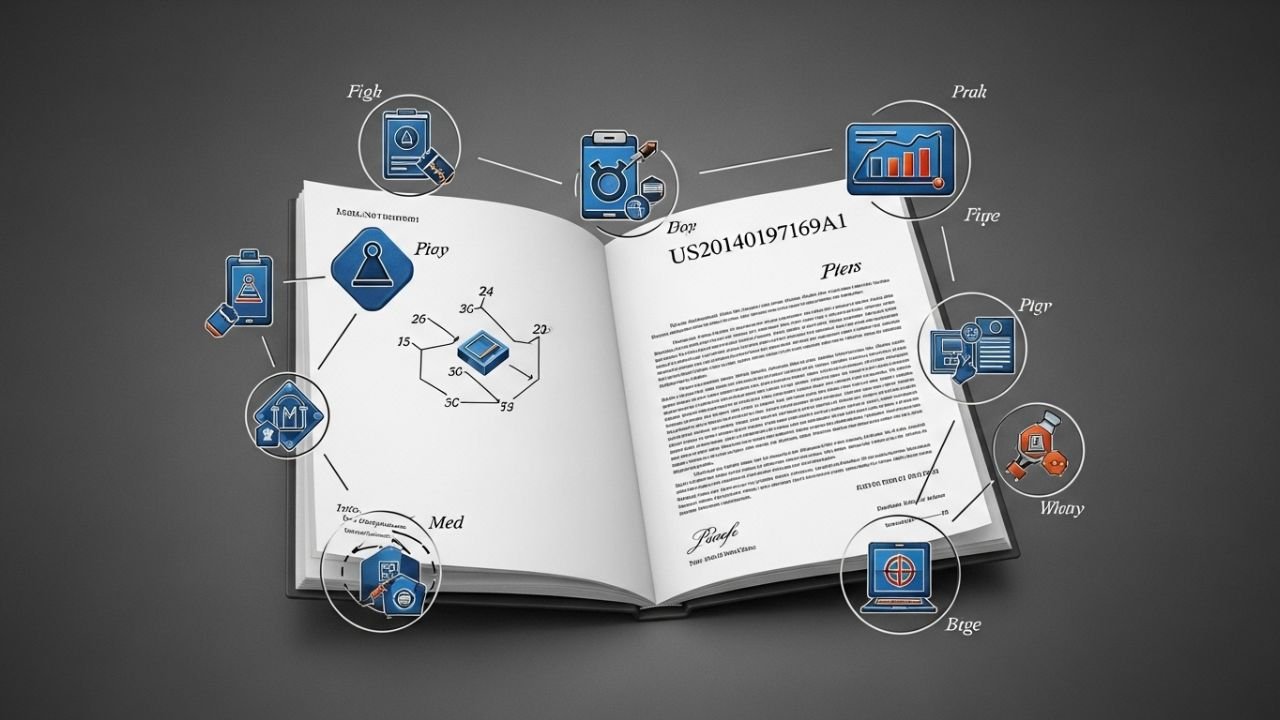Tech
US20140197169A1 Patent Overview: Key Features and Applications

Introduction to Patents
Patents play a crucial role in protecting innovations and fostering creativity. They not only secure the rights of inventors but also pave the way for new technologies that can change our everyday lives. Among them, the US20140197169A1 patent stands out due to its unique features and potential applications across various industries. If you’re curious about what makes this patent significant, you’re in the right place. Let’s dive deep into its key elements and uncover how it can impact future developments!
Understanding the US20140197169A1 Patent
The US20140197169A1 patent relates to a specific innovation within the technology field. Registered in 2014, it addresses unique methodologies that enhance operational efficiency. This patent showcases how inventive processes can revolutionize standard practices. It presents a clear framework that inventors and businesses can leverage for their development needs.
Understanding this patent requires an examination of its claims and specifications. These details elucidate the extent of protection provided, outlining what is covered and what remains open for future innovations.
Moreover, the documentation reveals insights into the technical aspects involved. This knowledge serves as a foundation for further research or applications in related industries.
By dissecting this patent’s structure, one gains clarity on its significance in driving technological advancements forward. Each component plays a vital role in shaping potential use cases across various sectors.
Key Features of the Patent
The US20140197169A1 patent introduces several noteworthy features that set it apart. One of its primary aspects is the innovative methodology for data processing. This approach significantly enhances efficiency and accuracy. Another key feature is its adaptability across various platforms. The design allows seamless integration with existing systems, minimizing the need for extensive alterations.
Security also plays a critical role in this patent. Advanced encryption methods protect sensitive information, ensuring user trust and compliance with regulations. Additionally, the user interface is designed to be intuitive. This helps users navigate complex functionalities without extensive training or prior experience. These features collectively contribute to the patent’s potential impact on industries reliant on data management and security solutions, making it an essential reference point for developers and businesses alike.
Potential Applications of the Patent
The US20140197169A1 patent opens up exciting possibilities across various sectors. Its innovative technology can greatly benefit the field of telecommunications, enhancing data transmission efficiency. In healthcare, the patent’s features may streamline patient monitoring systems. This leads to more accurate diagnostics and timely interventions.
Additionally, industries focused on smart devices could harness this patent for better connectivity. Imagine homes equipped with appliances that communicate seamlessly, optimizing energy usage effortlessly. Moreover, its applications in automotive technology present promising advancements in vehicle-to-vehicle communications. Enhanced safety measures could significantly reduce accident rates on roadways. Exploring potential uses further reveals opportunities in manufacturing processes as well. Automation and precision improvements can lead to cost savings and increased productivity for businesses striving for excellence.
Advantages and Limitations of the Patent
The US20140197169A1 patent presents several advantages that make it appealing to inventors and businesses. One key benefit is its innovative design, which can lead to improved efficiency in various applications. This may provide a competitive edge in the marketplace. Additionally, securing this patent grants exclusivity. This protection helps prevent competitors from using similar technology without permission, fostering an environment for potential financial gain.
However, there are limitations as well. The scope of the patent might be narrow, restricting its applicability to a specific industry or function. This could limit broad adoption across different sectors. Moreover, patents come with maintenance fees and require ongoing legal support to uphold their validity. These costs can deter smaller entities from pursuing innovations under such protections. Balancing these pros and cons is essential for anyone considering leveraging the US20140197169A1 patent.
How to Utilize the US20140197169A1 Patent
To effectively utilize the US20140197169A1 patent, start by thoroughly reviewing its claims and specifications. Understanding the core concepts will help you identify how it aligns with your projects or products. Consider conducting a market analysis to explore existing technologies that may intersect with this patent. This can reveal opportunities for innovation or improvement in your offerings.
Engage with legal experts specializing in intellectual property to ensure compliance while using this patented technology. Their guidance can prevent potential infringement issues down the line. Collaborate with engineers and developers to brainstorm applications of the patent. Together, you might discover unique methods to incorporate its features into new designs or processes. Additionally, consider filing for a licensing agreement if you’re looking to collaborate directly with the patent holder. This could open doors for partnerships and shared growth within your industry.
Conclusion
The US20140197169A1 patent presents a fascinating glimpse into innovative technology. Its unique features and applications highlight the potential for advancement in various sectors. By understanding its advantages, businesses can leverage this patent to gain a competitive edge. While there are some limitations to consider, the benefits outweigh them for many entities looking to enhance their operations or product offerings. Those interested in utilizing the US20140197169A1 patent should take proactive steps towards implementation and integration within their projects. With an ever-evolving landscape of technology, staying informed about patents like US20140197169A1 is crucial for fostering innovation and driving progress forward across industries.
Tech
The Benefits of Using icetana AI for Surveillance Needs

Key Highlights
Here are the key takeaways about Icetana’s AI-powered surveillance:
- Leverages self-learning artificial intelligence to understand what is normal in your environment.
- Provides real-time alerts for unusual events, helping prevent security incidents before they escalate.
- Transforms existing surveillance systems into a proactive security tool.
- Empowers security teams by reducing screen fatigue and highlighting only important events.
- Uses advanced video analytics to provide actionable insights from your camera network.
- Offers a scalable solution that integrates easily with your current video management software.
Introduction
Are your security teams struggling to keep up with endless hours of video footage? Manually monitoring multiple camera feeds is an impossible task, meaning critical events are often missed. For modern surveillance needs, you need a smarter approach. This is where icetana’s artificial intelligence solution comes in. It acts as a force multiplier for your security teams, transforming your surveillance from a reactive tool into a proactive shield that detects issues as they happen.
Key Features of icetana AI for Surveillance
Icetana’s video analytics software is designed to make your security operations more effective and efficient. By using sophisticated machine learning algorithms, the system learns to identify what truly matters, freeing your security teams from the noise of constant, uneventful video feeds.
This powerful security detection software doesn’t just watch; it understands. It actively highlights abnormal activities, allowing your personnel to focus their attention where it is needed most. Let’s explore the core features that make this possible.
Advanced Self-Learning Video Analytics
What makes Icetana truly unique is its advanced self-learning capability. Unlike traditional systems that rely on pre-programmed rules, icetana’s AI video analytics observes your camera feeds for a period to learn the normal patterns of movement and activity specific to your environment. This initial learning phase establishes a baseline of “normal.”
Once this baseline is set, the machine learning engine gets to work. It continuously watches for deviations from the norm. This means the system can identify a wide range of abnormal events without needing to be told what to look for.
This self-learning approach allows the system to:
- Focus on unusual and noteworthy events.
- Filter out routine activities that don’t require attention.
- Adapt to changes in the environment over time.
Real-Time Event Detection and Alerts
The ability to detect a problem is only half the battle; responding quickly is what truly matters. icetana empowers your team with real-time notifications for all detected events that deviate from the norm. Instead of discovering a security issue hours or days later, your team is alerted the moment something unusual happens.
This shift toward proactive security dramatically improves response times and can prevent incidents from escalating. Your team can immediately assess the situation and take appropriate action, turning your surveillance system into a live threat-detection tool.
The benefits of real-time alerts include:
- Immediate situational awareness.
- Drastically reduced incident response times.
- The ability to intervene before a situation worsens.
- Enhanced safety for staff and visitors.
How Icetana AI Surveillance Software Works
Getting started with Icetana’s artificial intelligence is a straightforward process. The software seamlessly connects to your existing video management system (VMS) and starts analyzing your video footage. It doesn’t require complex rule-setting or manual configuration to begin spotting potential security incidents.
The system is built on a simple yet powerful three-step process. It begins by learning your environment, then moves to highlighting only the important events, and finally engages in continuous learning to get smarter over time. The following sections will explain this process in more detail.
Continuous Learning and Adaptation
A key differentiator for Icetana is its commitment to continuous learning and adaptation. The system doesn’t just learn once and stop. Your environment is dynamic, and Icetana’s machine learning model evolves with it. Whether it’s a change in foot traffic patterns, new equipment, or seasonal shifts, the software adapts.
This ongoing process fine-tunes the system’s understanding of “normal,” ensuring it remains accurate and relevant. By constantly analyzing new surveillance data, it gets better at identifying unusual behaviour while reducing the number of false alarms. This is what sets it apart from static, rule-based systems that require manual updates to remain effective.
This intelligent adaptation means your security team can trust the alerts they receive. The system’s ability to evolve ensures it remains a valuable asset for the long term, helping your team make better, more informed decisions in real time.
Integration with Existing Security Camera Systems
One of the greatest benefits of icetana is its ability to integrate with the surveillance systems you already have in place. There is no need to overhaul your expansive network of cameras. The security software is designed to be compatible with widely used video management systems (VMS systems), making implementation simple and cost-effective.
Once connected, the software begins its intelligent process without disrupting your current operations. It taps into your existing camera streams and starts turning raw surveillance data into actionable intelligence. This seamless connection is the first step in upgrading your security posture.
The process is designed for simplicity and effectiveness:
| Step | Description |
| Step 1: Learning Phase | icetana AI observes camera feeds to learn the normal patterns of motion and activity in your unique environment, establishing a baseline without compromising privacy. |
| Step 2: Event Highlighting | The system intelligently filters out routine activity and highlights only the abnormal events, reducing screen fatigue and focusing your team’s attention. |
| Step 3: Continuous Evolution | icetana constantly learns and adapts to changes, improving its accuracy over time and helping your security team make smarter decisions. |
Industries and Applications of icetana AI in Australia
icetana’s technology is not limited to a single sector. It provides immense value to any organization managing large-scale surveillance, from sprawling shopping centres and commercial spaces to public precincts. The system is designed to support the security operations centre in monitoring vast areas effectively.
Whether it’s a shopping mall aiming to improve customer safety or a corporate campus needing to protect its assets, icetana offers a flexible and powerful solution. The software helps teams in various industries stay ahead of security threats.
Large Facilities, Commercial Spaces, and Public Settings
Managing security for large facilities presents a significant challenge. The sheer scale of shopping centres, university campuses, and public plazas means that security staff in a control room cannot possibly monitor all cameras at once. This is where Icetana excels, providing active monitoring of security surveillance networks.
The AI does the heavy lifting by watching every camera feed simultaneously. When it detects an anomaly in a specific area, it sends an alert with the relevant video clip to the operators. This allows a small team to effectively manage security across vast commercial spaces and other large-scale environments.
icetana is particularly effective in:
- Shopping centres and retail environments.
- Educational campuses and safe city initiatives.
Addressing Safety and Security Challenges Across Sectors
Modern organizations face a host of safety and security challenges, from slip-and-fall incidents to unauthorized access and theft. Traditional surveillance often only helps after an incident has occurred. icetana helps you get ahead of these potential risks by identifying the precursors to common security issues.
By flagging unusual behavior in real time, the system gives your security staff the chance to intervene and de-escalate situations. This proactive approach not only improves prevention rates but also contributes to a safer environment for everyone. It helps mitigate liability and ensures a faster response when every second counts.
icetana helps you address a range of issues, including:
- Proactively identifying potential security breaches and safety hazards.
- Mitigating risks related to capacity planning and site efficiency.
Conclusion
In conclusion, Icetana AI provides a transformative approach to surveillance, ensuring your security needs are met with cutting-edge technology. Its advanced self-learning video analytics and real-time event detection significantly enhance safety measures across various sectors. By integrating seamlessly with existing security systems, icetana AI adapts to the unique challenges of large facilities, commercial spaces, and public settings. This adaptability not only improves efficiency but also fosters a safer environment for everyone involved. If you’re interested in learning more about how icetana AI can elevate your surveillance efforts, don’t hesitate to reach out and explore the numerous benefits it offers.
Frequently Asked Questions
Is iCetana AI suitable for large-scale surveillance environments?
Yes, absolutely. icetana is specifically designed for large-scale surveillance systems. It excels at managing an expansive network of cameras, providing active monitoring of all video feeds simultaneously. This empowers small security teams to effectively oversee vast areas that would be impossible to cover manually.
What differentiates icetana AI from other video analytics solutions?
The key differentiator is its self-learning AI. Instead of relying on rigid, pre-defined rules, icetana’s machine learning model learns what is “normal” from your unique surveillance data. This allows it to identify truly unusual events with high accuracy, significantly reducing the false alarms that plague other systems.
How can I contact Icetana AI for more information?
Getting in touch is easy. To learn more about our security detection software, you can visit the official Icetana website. There, you can book a free demo to see the system in action or request a quote tailored to your organization’s specific needs. Contact us today to find out more.
Tech
Simpcit6: A Complete Guide to Its Features, Benefits, and Applications

Introduction: Why Simpcit6 Is Gaining Popularity
In a world where efficiency and productivity are crucial, Simpcit6 has emerged as a powerful tool designed to streamline processes and simplify complex tasks. Whether for businesses, educational institutions, or personal productivity, Simpcit6 provides a reliable and user-friendly platform that meets modern demands. This guide explores everything you need to know about Simpcit6, including its features, advantages, and real-world applications.
What Exactly Is Simpcit6?
Simpcit6 is a modern solution that combines intuitive technology with advanced functionality to help users optimize their workflow. Unlike traditional software, Simpcit6 is designed to be flexible, scalable, and accessible to all users, regardless of technical expertise. Its primary goal is to reduce manual effort, improve efficiency, and provide actionable insights for smarter decision-making.
Key Characteristics of Simpcit6:
-
User-Friendly Interface: Easy navigation for all levels of users.
-
Automation: Streamlines repetitive tasks automatically.
-
Scalable Design: Effective for both small-scale and large-scale operations.
-
Data-Driven Insights: Real-time analytics for informed decisions.
Top Features of Simpcit6
Understanding the key features of Simpcit6 is essential for leveraging its full potential.
1. Intuitive Dashboard
Simpcit6 features an intuitive dashboard that displays important metrics, progress, and notifications. This central hub allows users to track tasks efficiently and access tools with minimal effort.
2. Automation Capabilities
With advanced automation, Simpcit6 reduces the need for manual intervention. Tasks such as scheduling, reporting, and workflow management can be automated, freeing up time for higher-value activities.
3. Customizable Workflows
Every user’s needs are different, and Simpcit6 accommodates this through customizable workflows. Users can create personalized setups, adjust settings, and design processes that fit their requirements.
4. Real-Time Reporting
Simpcit6 offers real-time reporting and analytics, allowing users to monitor progress, identify bottlenecks, and make data-driven decisions. These insights enhance operational efficiency and strategic planning.
5. Enhanced Security
Security is a top priority for Simpcit6. Advanced encryption, access controls, and data protection protocols ensure that sensitive information remains safe from unauthorized access.
Benefits of Using Simpcit6
The adoption of Simpcit6 brings multiple advantages that improve both individual and organizational productivity:
-
Boosted Efficiency: Automation reduces time spent on repetitive tasks.
-
Improved Accuracy: Minimizes human error through systematic workflows.
-
Cost Savings: Streamlined operations save resources and reduce expenses.
-
Collaboration: Facilitates teamwork with shared access and integrated tools.
-
Scalability: Adaptable to evolving demands, from personal projects to enterprise-level operations.
Simpcit6 in Real-Life Applications
Simpcit6 is versatile, and its applications extend across industries:
1. Business and Corporate Use
Companies utilize Simpcit6 for project management, process automation, and team collaboration. Its features allow teams to complete projects faster while maintaining quality and accuracy.
2. Education and Learning
Educators can use Simpcit6 to manage schedules, track student progress, and streamline remote learning. Its automation capabilities reduce administrative workload and enhance teaching efficiency.
3. Personal Productivity
For individuals, Simpcit6 acts as a personal productivity assistant, helping manage tasks, organize schedules, and monitor progress toward goals.
4. IT and Development
Developers integrate Simpcit6 into their systems to optimize workflow automation, manage data, and improve operational efficiency.
How to Get Started with Simpcit6
Starting with Simpcit6 is simple and user-friendly:
-
Sign Up: Register an account on the official platform.
-
Set Preferences: Customize settings according to your workflow and objectives.
-
Explore Features: Learn how to use dashboards, automation tools, and analytics.
-
Integrate Applications: Connect Simpcit with other software for seamless operation.
-
Monitor and Adjust: Track performance metrics and refine your workflow based on insights.
Best Practices for Maximizing Simpcit
To unlock the full potential of Simpcit, users should:
-
Keep the platform updated with the latest features.
-
Leverage automation to reduce repetitive tasks.
-
Customize dashboards for personal or organizational needs.
-
Utilize analytics to identify areas of improvement.
-
Train teams for effective adoption and collaborative usage.
Future of Simpcit6
With continuous updates and growing demand for productivity solutions, Simpcit6 is poised to become a leading platform in workflow optimization. Its combination of automation, customization, and real-time analytics ensures that it will remain relevant for businesses, educators, and individuals seeking efficient solutions.
Conclusion
In conclusion, Simpcit is a versatile, efficient, and secure platform designed to simplify workflows and enhance productivity. Its unique features, including automation, real-time analytics, and customizable workflows, make it an indispensable tool for modern users. Whether for professional, educational, or personal use, Simpcit offers practical solutions that save time, reduce effort, and improve outcomes. Embracing Simpcit is not just about using a tool—it’s about optimizing your workflow for greater efficiency and success.
FAQs
What is Simpcit?
Simpcit is a versatile platform designed to streamline workflows, automate tasks, and improve productivity for businesses, educators, and individuals.
How does Simpcit improve efficiency?
Simpcit automates repetitive tasks, provides real-time analytics, and allows customizable workflows, saving time and reducing manual effort.
Is Simpcit suitable for small businesses?
Yes, Simpcit is scalable and works efficiently for small businesses, large enterprises, and personal productivity needs.
Can Simpcit integrate with other software?
Yes, Simpcit supports integration with various applications, allowing seamless workflow management across platforms.
Is Simpcit secure for sensitive data?
Absolutely. Simpcit uses advanced encryption and access controls to ensure data security and privacy.
Tech
GlarklyHub: Your Ultimate Guide to a Dynamic Community

Introduction to GlarklyHub
Welcome to GlarklyHub, where community and connection come together in a vibrant tapestry of ideas and experiences. If you’re searching for a place that fosters creativity, collaboration, and camaraderie, look no further. GlarklyHub is more than just a platform; it’s an evolving network designed for individuals who want to share their passions and grow alongside like-minded people.
Picture this: A dynamic space buzzing with enthusiasm, where every conversation sparks inspiration. Whether you’re an artist seeking feedback or someone eager to learn new skills, GlarklyHub opens the door to endless possibilities. Join us as we explore what sets this community apart from the rest!
What Makes GlarklyHub Unique?
GlarklyHub stands out in the crowded landscape of online communities. It offers a blend of inclusivity and innovation that is hard to find elsewhere. One key feature is its user-driven content. Members can share ideas, projects, or resources, fostering collaboration among like-minded individuals. This creates a vibrant atmosphere where creativity thrives.
Another unique aspect is the emphasis on skill-sharing. Whether you’re an expert coder or a hobbyist artist, there’s always something new to learn from fellow members. The platform also supports diverse interests through specialized groups tailored to various topics and passions. This makes it easy for users to connect with others who share their enthusiasm.
GlarklyHub prioritizes member feedback. The community actively shapes its evolution based on what its users want and need ensuring everyone feels heard and valued within this dynamic space.
How to Join GlarklyHub Community
Joining the GlarklyHub community is a straightforward process designed for everyone. First, visit the official GlarklyHub website. There, you’ll find a clear “Join Us” button prominently displayed.
Click it to access the registration form. Fill in your details like name, email address, and interests. This helps tailor your experience right from the start. Once you submit your information, keep an eye on your inbox. You’ll receive a confirmation email with further instructions.
After confirming your account, dive into community discussions or explore various interest groups that spark joy for you. Engage with fellow members right away! The welcoming atmosphere encourages interaction and collaboration among newcomers and veterans alike. Don’t forget to customize your profile to reflect who you are within this vibrant hub!
Benefits of Being a Part of GlarklyHub
Being part of GlarklyHub opens doors to countless opportunities. You connect with like-minded individuals who share your passions and interests. This creates a vibrant atmosphere for collaboration. Members enjoy access to exclusive resources. From informative webinars to insightful articles, the knowledge shared within the community is invaluable. You’ll always be learning something new.
Networking plays a significant role in personal and professional growth. The connections you make here can lead to collaborations or career advancements you might not find elsewhere. GlarklyHub encourages creativity through various challenges and projects designed for members. Engaging in these activities sparks innovation and inspiration, helping you think outside the box.
Being part of this dynamic community means support from peers during both triumphs and challenges. You’re never alone on your journey; encouragement is just around the corner when you need it most.
Activities and Events in GlarklyHub
At GlarklyHub, the calendar is always buzzing with vibrant activities and events that cater to diverse interests. From workshops led by industry experts to creative art sessions, there’s something for everyone. Members can participate in networking meetups designed to forge connections and share ideas. These informal gatherings often lead to collaborations that spark innovation.
For those who love fitness, group classes ranging from yoga to dance are a regular feature. They not only promote health but also foster camaraderie among participants. Cultural nights offer a delightful way for members to showcase their talents be it music, poetry, or storytelling. It’s an opportunity for creativity and self-expression within the community. Seasonal festivals add another layer of excitement. These celebrations bring together families and individuals alike, complete with food stalls, games, and entertainment that highlight local culture.
Testimonials from Members of GlarklyHub
Members of GlarklyHub have shared their experiences, and the feedback is nothing short of inspiring. Many highlight the sense of belonging they’ve found within this dynamic community. One member noted how connecting with like-minded individuals helped them grow both personally and professionally. The networking opportunities are often described as invaluable.
Another testimonial emphasized the diverse range of activities available, making it easy to find something that resonates with individual interests. Whether it’s workshops or social events, members feel engaged and energized.
Many express appreciation for the supportive atmosphere where everyone encourages each other’s growth. This spirit fosters lasting friendships and collaborations that extend beyond online interactions. The stories reflect a deep commitment to fostering connections and building a thriving community together in GlarklyHub. Each voice adds richness to what makes this space truly unique.
Conclusion: Why You Should Join GlarklyHub Today
Joining GlarklyHub opens the door to a vibrant community where connections flourish. You’ll find like-minded individuals eager to share their experiences and knowledge. The opportunities for personal growth and collaboration are endless.
Being part of GlarklyHub means accessing exclusive events, resources, and activities that inspire creativity. From networking sessions to workshops, there’s something for everyone here.
Don’t miss out on the chance to enrich your life through meaningful interactions. Whether you’re seeking support or looking to contribute your skills, GlarklyHub welcomes all with open arms. Take the leap today; become part of something special at glarklyhub!
Tech
2021 australian hardwood conference room table

Introduction to the growing trend of using Australian hardwood for furniture
In recent years, there has been a notable shift towards sustainable and locally sourced materials for furniture. One standout choice in this movement is Australian hardwood. Known for its durability, aesthetic appeal, and unique character, it’s no surprise that businesses are increasingly opting for Australian hardwood conference room tables to make a statement. These tables not only serve as functional pieces but also embody the rich natural heritage of Australia.
Picture your next meeting set around a stunning table crafted from premium timber; it adds an air of sophistication and professionalism to any space. As companies look for ways to enhance their work environments, investing in quality furniture made from Australian hardwood seems like an obvious choice—one that elevates both style and sustainability while fostering collaboration among team members. Let’s explore why choosing a 2021 Australian hardwood conference room table could be one of the best decisions you make for your business this year!
Benefits of using Australian hardwood for conference room tables
Australian hardwood is renowned for its durability. It stands up to the rigors of daily use, making it perfect for busy conference rooms. The natural beauty of these woods adds warmth and sophistication. Each piece tells a unique story with its distinct grain patterns and rich colors. Sustainability is another key benefit. Many Australian hardwoods are sourced from well-managed forests, ensuring an eco-friendly choice for environmentally conscious businesses.
Additionally, using local materials supports the economy. Investing in Australian products fosters growth and community development. Hardwood tables also offer excellent acoustics during meetings. Their density helps absorb sound, creating a more focused atmosphere. They require minimal maintenance while providing longevity. A well-cared-for table can last many years if you choose wisely from reputable sources.
Popular types of Australian hardwood used for furniture
Australian hardwood is known for its durability and stunning appearance. Several species stand out in the furniture market. Blackbutt is a popular choice, prized for its golden hues and striking grain patterns. It’s perfect for conference room tables due to its strength and resilience. Another favorite is Spotted Gum, which features unique spots that add character. Its natural beauty combined with hardness makes it ideal for high-traffic areas.
Then there’s Jarrah, renowned for its deep reddish-brown color. This wood ages beautifully, developing a rich patina over time that enhances any office environment. Ironbark stands as one of the hardest woods available. Its dense structure not only offers longevity but also an impressive aesthetic appeal. These hardwoods provide an excellent blend of functionality and style, making them a top choice among businesses looking to invest in quality furniture.
Factors to consider when choosing an Australian hardwood conference room table
When selecting an Australian hardwood conference room table, consider the size of your space. The dimensions should accommodate both the number of participants and the layout of your room. Next, think about the wood species. Each type offers distinct colors and grain patterns. For instance, Blackbutt is light in hue while Spotted Gum showcases rich brown tones. Choose one that complements your office decor.
Durability is vital too. Look for hardwood options known for their strength and resistance to wear over time. Tables made from Jarrah or Ironbark are great choices due to their robustness. Don’t forget the finish! A high-quality finish not only enhances appearance but also protects against stains and scratches. Keep budget considerations in mind. While investing in quality pays off long-term, ensure it aligns with your financial plan before making a decision on a 2021 Australian hardwood conference room table.
Maintenance and care tips for keeping your table in top condition
To keep your Australian hardwood conference room table looking its best, start with regular dusting. Use a soft microfiber cloth to avoid scratches and maintain its finish. Spills can happen during meetings. Always wipe them up promptly using a damp cloth, followed by drying the surface thoroughly. This helps prevent stains from setting in.
Consider applying a protective oil or wax periodically. It nourishes the wood and adds an extra layer of protection against wear and tear. Avoid placing hot items directly on the table’s surface. A coaster or trivet can save you from unsightly marks that could damage the finish over time. Position your table away from direct sunlight to prevent fading and warping. Keeping it in a stable environment will ensure longevity and beauty for years to come.
Examples of companies and organizations using Australian hardwood conference room tables
Many businesses are embracing the elegance and durability of Australian hardwood conference room tables. Leading firms such as Atlassian have made a statement with stunning timber pieces that reflect their commitment to sustainability and quality. Government agencies across Australia also opt for these tables. They appreciate how these natural materials convey professionalism while fostering collaborative environments during meetings.
Educational institutions, like universities, utilize Australian hardwood in their meeting spaces. This choice not only enhances aesthetics but also provides a strong foundation for productive discussions among faculty and students alike. Moreover, boutique hotels incorporate handcrafted wooden tables into their design schemes. These unique furnishings create inviting atmospheres that leave lasting impressions on guests during conferences or events. With such diverse applications, it’s clear that Australian hardwood conference room tables resonate across various sectors.
Conclusion: Why investing in a 2021 Australian hardwood conference room table is a smart choice for your business
Investing in a 2021 Australian hardwood conference room table can elevate your workspace in multiple ways. Not only does it provide a stylish and sophisticated atmosphere, but it also reflects a commitment to sustainability by utilizing locally sourced materials. The durability of Australian hardwood ensures that your investment will last for years, making it both practical and cost-effective.
A well-crafted conference table serves as the centerpiece of any meeting space, fostering collaboration and creativity among team members. With options like Blackbutt or Spotted Gum, you can choose a wood type that aligns with your brand’s aesthetic while enjoying the natural beauty each species offers.
Furthermore, incorporating an Australian hardwood table into your office design speaks volumes about your company’s values. It signifies quality craftsmanship and supports local industries—an appealing message to clients and employees alike.
When you choose an Australian hardwood conference room table for your business needs, you’re not just selecting furniture; you’re making a statement about who you are as an organization. It’s an opportunity to invest wisely in both functionality and style something every modern workplace should prioritize.
Tech
lnl3d vulcan vs entina x40 v3: Which 3D Printer Reigns Supreme?

Introduction to 3D Printing
3D printing has revolutionized the way we create and innovate, opening up a world of possibilities for hobbyists and professionals alike. With endless applications—from prototyping to custom models—having the right printer can make all the difference. Today, we’re diving into two popular contenders in this space: the Lnl3d Vulcan and the Entina X40 V3. Both promise impressive features and capabilities, but which one truly stands out? Let’s explore what each brings to the table as we compare these heavyweights of 3D printing technology.
Lnl3d Vulcan: Features, Pros, and Cons
The Lnl3d Vulcan is designed for both novices and seasoned users. Its robust construction ensures durability, while the sleek design adds a modern touch to any workspace.
Equipped with a large build volume, it allows for impressive print sizes. This printer supports various materials, including PLA, ABS, and PETG. The heated bed enhances adhesion and minimizes warping during printing.
One of its standout features is the user-friendly touchscreen interface. This makes navigation seamless for everyone. However, setup can be time-consuming for some users. On the downside, the noise level during operation might be noticeable in quiet environments. Additionally, while it offers excellent print quality, fine details may require tweaking settings to achieve optimal results.
Entina X40 V3: Features, Pros, and Cons
The Entina X40 V3 is a powerhouse in the realm of 3D printing. Known for its robust build and impressive features, this printer caters to both beginners and seasoned enthusiasts alike. One standout feature is its large print volume, which allows for bigger projects without compromising detail. The dual extruder capability offers versatility, enabling users to experiment with multiple materials or colors seamlessly.
Users rave about the high precision and smooth finishes it produces. Its user-friendly touchscreen interface simplifies navigation, making setup quick and straightforward. However, some drawbacks do exist. Assembly can be time-consuming for those unfamiliar with 3D printers. Additionally, while customer support has improved over time, there are still occasional delays in response.
Despite these minor issues, the Entina X40 V3 continues to impress many in the 3D printing community due to its efficiency and innovative design.
Comparison of Print Quality and Speed
When comparing the Lnl3d Vulcan and the Entina X40 V3, print quality is a key consideration. The Lnl3d Vulcan shines with its high-resolution capabilities, delivering intricate details that enthusiasts often seek. Its layer adhesion is impressive, reducing the risk of delamination in complex prints.
On the other hand, the Entina X40 V3 offers robust performance as well. While it might not match every fine detail of the Vulcan, its consistency makes it a favorite among users who prioritize reliability over sheer precision.
Speed also plays an essential role in this comparison. The Vulcan tends to be slightly slower due to its emphasis on quality settings; however, many users find that waiting for superior output is worth it.
Conversely, the Entina X40 V3 boasts faster print speeds without compromising too much on quality ideal for those needing quicker results in their projects. Each printer has strengths tailored to different user needs and preferences.
Price Comparison
When it comes to price, both the Lnl3d Vulcan and Entina X40 V3 offer competitive options for different budgets. The Lnl3d Vulcan typically falls into a mid-range category. It provides solid features for its cost, making it appealing to hobbyists who want good quality without breaking the bank.
On the other hand, the Entina X40 V3 is often seen as more budget-friendly. It’s designed to attract beginners or those looking for an affordable entry into 3D printing while still delivering decent performance. Pricing can vary based on retailers and any ongoing promotions. Buyers should also consider long-term costs like materials and maintenance when evaluating value.
In this dynamic market, finding the right balance between initial investment and overall capability remains key for potential users exploring these two models.
User-Friendliness and Customer Support
User-friendliness is a critical factor when choosing between the lnl3d Vulcan and Entina X40 V3. Both printers offer intuitive interfaces, but they cater to different levels of expertise. The lnl3d Vulcan boasts a touchscreen display that simplifies navigation through settings and options. Even beginners may find it easy to set up and start printing quickly.
On the other hand, the Entina X40 V3 has a slightly more complex interface that could require some learning for newcomers. However, experienced users might appreciate its advanced features once they’ve mastered them. Customer support can define your experience with any printer. The lnl3d team is known for responsive service, providing assistance via online channels swiftly.
Entina also offers decent support options but may not be as quick in response times compared to lnl3d. For those who prefer hands-on help or troubleshooting guidance, this aspect might influence their decision significantly.
Final Verdict: Which 3D Printer is the Better Investment?
When comparing the lnl3d Vulcan and Entina X40 V3, it becomes evident that both machines have their strengths. The choice ultimately depends on what you prioritize in a 3D printer.
If reliability and ease of use matter most to you, the lnl3d Vulcan might take the lead. Its straightforward setup and consistent performance make it appealing for beginners and seasoned users alike. On the other hand, if versatility in materials is your focus, consider the Entina X40 V3. This printer excels in handling diverse filament types, allowing for creative exploration without limitations.
Your budget also plays a crucial role. While both printers offer good value, one may suit your financial plan better than the other based on features offered at a certain price point. Weigh these aspects against your individual needs to decide which 3D printer aligns best with your goals as a maker or designer.
Conclusion
When it comes to 3D printing, the choice between the Lnl3d Vulcan and Entina X40 V3 can significantly impact your projects. Both printers bring unique strengths to the table. The Lnl3d Vulcan impresses with its robust build quality and versatility, making it a great option for various applications. Meanwhile, the Entina X40 V3 stands out for its speed and user-friendly features, appealing especially to beginners.
Evaluating print quality reveals that both models have their merits; however, specific nuances in detail may sway users toward one or the other based on personal preferences. Price is another crucial factor each printer offers value but caters to different budgets.
User-friendliness plays an important role as well. Those new to 3D printing might find themselves more comfortable with the intuitive interface of the Entina X40 V3, while seasoned users may appreciate what the Lnl3d Vulcan brings.
Determining which model reigns supreme depends on individual needs and priorities in 3D printing endeavors. Whether you lean towards reliability or cutting-edge technology will guide your final decision on this exciting journey into additive manufacturing.
Tech
15mm x1 Plan B Muzzle Device: Performance, Compatibility & Features

Introduction to the 15mm x1 Plan B Muzzle Device
When it comes to enhancing firearm performance, the right muzzle device can make all the difference. Enter the 15mm x1 Plan B Muzzle Device a game-changer for shooting enthusiasts and professionals alike. Designed with precision engineering in mind, this muzzle device not only elevates your shooting experience but also offers a range of benefits that are hard to ignore.
Whether you’re looking for improved accuracy or reduced recoil, understanding what makes the 15mm x1 Plan B Muzzle Device stand out is essential. Join us as we dive into its performance metrics, compatibility options, unique features, and real user feedback that paint a complete picture of this impressive accessory. Get ready to discover why this muzzle device could be exactly what you need for your next shoot!
Benefits of Using a Muzzle Device
A muzzle device offers several advantages for firearm enthusiasts. First, it significantly reduces recoil. This makes follow-up shots more manageable and improves overall accuracy. Another benefit is the reduction of muzzle rise. When firing rapidly, maintaining a stable aim can be challenging. A well-designed muzzle device helps keep your sights on target, allowing for quicker engagements.
Sound suppression is another noteworthy feature. Many devices are designed to minimize noise levels, making shooting less disruptive in various settings. Additionally, some muzzle devices enhance flash suppression. In low-light situations, this can help maintain visibility while preventing blinding flashes from obscuring your view.
They often serve as mounting points for accessories like suppressors or compensators. This versatility allows shooters to customize their setups based on personal preferences and needs.
Performance of the 15mm x1 Plan B Muzzle Device
The 15mm x1 Plan B Muzzle Device stands out in terms of performance, offering shooters improved control and reduced recoil. Its precision-engineered design ensures that it effectively manages muzzle rise during rapid fire. Shooters appreciate how this device enhances accuracy by minimizing disturbances during shot sequences. The result is a smoother shooting experience, allowing for follow-up shots with greater ease.
Many users report noticeable improvements in their grouping patterns when using this muzzle device. Additionally, its ability to redirect gas contributes to more stable handling. Whether on the range or in tactical situations, the 15mm x1 Plan B proves reliable under various conditions. This reliability fosters confidence among users who demand consistent performance from their firearms accessories.
Compatibility with Different Firearms
The 15mm x1 Plan B Muzzle Device shines when it comes to compatibility. Designed with versatility in mind, it fits a range of firearms that utilize the 15mm x1 threading standard. Whether you own a precision rifle or an AR platform, this muzzle device adapts easily. The robust design ensures secure attachment without compromising performance.
You can count on seamless integration across various calibers. It’s engineered to enhance shooting experiences without the hassle of constant modifications. This adaptability makes it appealing for both casual shooters and serious enthusiasts alike. Transitioning between different firearms becomes smoother, allowing users to focus more on their aim than their gear setup.
With its broad compatibility spectrum, the 15mm x1 Plan B Muzzle Device proves to be an essential accessory for any firearm enthusiast looking for flexibility and reliability in one package.
Unique Features of the 15mm x1 Plan B Muzzle Device
The 15mm x1 Plan B Muzzle Device stands out with its innovative design, tailored for precision and performance. Crafted from high-grade materials, it offers exceptional durability while remaining lightweight. One of its most notable features is the advanced recoil mitigation system. This design effectively reduces muzzle rise, allowing shooters to maintain better control during rapid-fire sequences.
Additionally, the device includes a unique thread pattern that ensures easy attachment and removal without compromising stability. This user-friendly aspect appeals to both seasoned professionals and novice enthusiasts alike.
Its sleek aesthetic adds a modern touch to any firearm setup, making it visually appealing as well as functional. The device’s compatibility with various calibers amplifies its versatility across different platforms, giving users more options for customization in their shooting experience.
User Reviews and Feedback
User reviews of the 15mm x1 Plan B Muzzle Device highlight its strong performance and reliability. Many users praise its ability to significantly reduce recoil, allowing for quicker follow-up shots.
Some shooters appreciate how it minimizes muzzle rise during rapid fire. They note that it enhances their shooting experience, particularly in competitive environments.
Feedback also emphasizes ease of installation. Several customers mention that they had no trouble mounting it on their firearms, which is a big plus for DIY enthusiasts. However, not all feedback is glowing. A few users expressed concerns about weight. They felt that the additional mass could affect balance on lighter rifles.
Despite this, most reviews are overwhelmingly positive. The consensus points toward the device’s effectiveness and quality construction as major selling points for many gun owners looking to upgrade their setups.
Comparison with Other Muzzle Devices in the Market
When examining the 15mm x1 Plan B muzzle device, it’s essential to compare it with other options available in the market. Many muzzle devices claim to reduce recoil and improve accuracy, but few match the precision engineering of this model.
Competitors often focus on flash suppression or sound reduction, yet they may compromise on overall performance. The Plan B stands out by offering a blend of both features without sacrificing quality.
Some brands feature adjustable settings for tuning performance. This can be an advantage for seasoned shooters looking for customization. However, they might lack ease of installation that is one of the key strengths of the 15mm x1 design.
Price points vary widely as well. While some alternatives are cheaper up front, they often require additional accessories or replacements down the line—leading users to spend more overall compared to investing in a robust option like the Plan B from day one.
Proper Installation and Maintenance Tips
Installing the 15mm x1 Plan B Muzzle Device requires precision. Start by ensuring your firearm is unloaded and safe to handle. Use a torque wrench to securely attach the device, following the manufacturer’s recommended specifications. This guarantees optimal performance without damaging threads.
Regular maintenance is essential for longevity. Clean the muzzle device after each use, removing carbon buildup with a solvent-soaked cloth or brush. Pay attention to any wear and tear; replace worn parts promptly.
Inspect the alignment periodically to ensure it remains straight on your firearm’s muzzle. Misalignment can affect accuracy and lead to unwanted recoil dynamics.
Additionally, store your firearm in a dry environment when not in use to prevent rust or corrosion on both your gun and muzzle device components. Taking these steps will enhance functionality while safeguarding your investment in quality equipment.
Conclusion and Recommendations for Potential Buyers
When considering the 15mm x1 Plan B Muzzle Device, it’s clear it stands out in a crowded market. This device not only enhances firearm performance but also ensures compatibility with various models. Users have praised its unique features and effective design.
For those looking to improve accuracy and reduce recoil, this muzzle device is worth exploring. Its solid construction means durability over time, making it a reliable choice for both novice shooters and seasoned professionals alike.
Before making a purchase, consider how it aligns with your specific needs. Reading user reviews can provide additional insights into real-world performance. Investing in the 15mm x1 Plan B Muzzle Device could significantly enhance your shooting experience while ensuring ease of installation and maintenance.
-

 Tech1 day ago
Tech1 day agoSimpcit6: A Complete Guide to Its Features, Benefits, and Applications
-

 Blog3 months ago
Blog3 months agoThe Role of i̇ns in Digital Communication: Enhancing Your Online Presence
-

 Entertainment2 months ago
Entertainment2 months agoмаријин трг: A Complete Guide to the Famous Square
-

 Home improvement2 months ago
Home improvement2 months agoTop Ways to Style a Round Jute Rug in Small Rooms
-

 Blog2 months ago
Blog2 months agoWhy Fesbuka is the Next Big Thing in Social Networking
-

 Blog3 months ago
Blog3 months agoWhat Is Hothaylost? Everything You Need to Know
-

 Blog3 months ago
Blog3 months agoDympigal: A Comprehensive Guide to Its Features and Applications
-

 Blog2 months ago
Blog2 months agoSimpcitu Explained: A Simple Yet Powerful Concept
